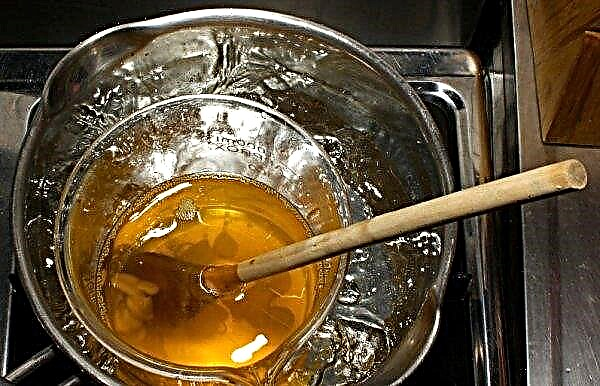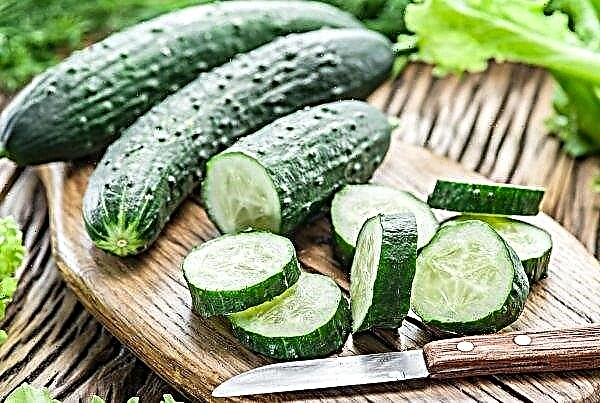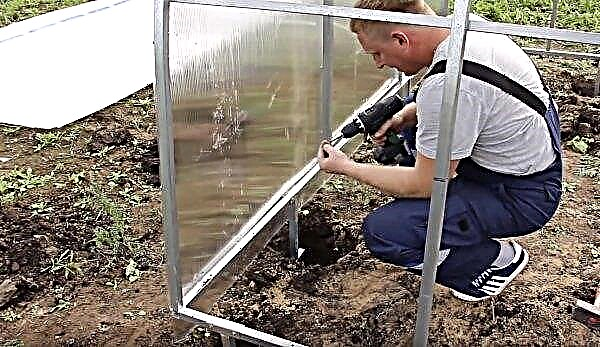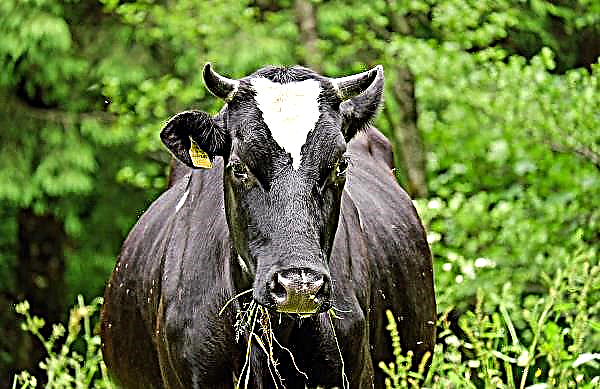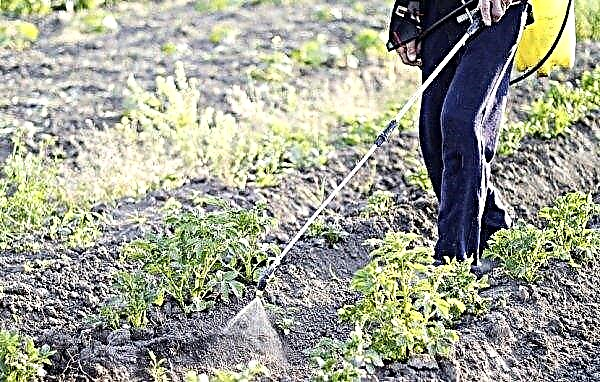When breeding ducks, poultry farmers often face a lot of difficulties associated with the health of birds at different stages of development. About the main diseases dangerous for ducks and how to treat them, read below.
Common causes of disease in ducks
The main causes of the spread of diseases among ducks:
- selection of a breed poorly adapted to the climatic conditions of the growing region;
- neglect of the rules of care - unsanitary conditions, unbalanced diet, poorly insulated rooms for the winter period;
- infections and parasites;
- lack of walking area with a reservoir;
- seasonal vitamin deficiency;
- keeping in one room individuals of different ages.
Did you know? Ducks are flocks of birds and constantly stick together, except for swimming. Using this feature, you can control large flocks of poultry with the help of specially trained dogs.
Diseases of ducks, their symptoms and treatment at home
To understand how to treat a bird, you must first determine the cause and type of pathogen. Often, the owners immediately begin to water the bird with Bicillin when they notice that its neck is crooked, although in this case it is better to take a blood test first to find out the cause. Different groups of antibiotics act on individual pathogens, so their inadequate use can lead to serious complications. Most often, neck curvature in young ducks occurs against a background of bacterial diseases that give a complication to the nervous system. However, the cause may be banal vitamin deficiency. So the lack of vitamins of group B, D and calcium is manifested. If at the autopsy of a dead bird or sent for slaughter, it is found that its liver is enlarged, this may be a symptom of one of several diseases:
Most often, neck curvature in young ducks occurs against a background of bacterial diseases that give a complication to the nervous system. However, the cause may be banal vitamin deficiency. So the lack of vitamins of group B, D and calcium is manifested. If at the autopsy of a dead bird or sent for slaughter, it is found that its liver is enlarged, this may be a symptom of one of several diseases:
- salmonellosis;
- tuberculosis.
Ducks fall to their feet
The following factors can provoke this pathology:
- some types of vitamin deficiency;
- infection with external parasites;
- infections.
 Difficulties with treatment and identification usually begin with infectious lesions. The infection spreads quickly from sick to healthy individuals, and also constitutes a threat to human health.
Difficulties with treatment and identification usually begin with infectious lesions. The infection spreads quickly from sick to healthy individuals, and also constitutes a threat to human health.Pluck feathers from each other
Plucking feathers with ducks from each other is a dangerous phenomenon that needs to be eliminated as soon as possible. The main danger is that when the pen is removed, the skin is broken and an infection gets into the wound. Feeling the blood, the attacking bird becomes even more aggressive, and begins to peck the victim. Most often, cannibalism manifests itself in individuals aged 60 days.
Pathological behavior is determined by several factors:
- poor lean diet - overfeeding or lack of sufficient protein in the feed;
- arginine deficiency - a decrease in arginine in the blood to 3.9 (norm 6.9) provokes mass eating of feather cover;
- low air humidity - overdried air leads to breaking off the feather, which makes birds want to get rid of it.
 You can solve the problem using special compound feeds containing a large amount of nutrients necessary for the development of poultry at different stages of life. If there is such a complication as cannibalism, the feed must be enriched with protein elements of animal origin. Once a week, add 50 g of minced meat, animal fat to each individual. It is also necessary to increase the content of meat and bone meal and dairy products in the feed.
You can solve the problem using special compound feeds containing a large amount of nutrients necessary for the development of poultry at different stages of life. If there is such a complication as cannibalism, the feed must be enriched with protein elements of animal origin. Once a week, add 50 g of minced meat, animal fat to each individual. It is also necessary to increase the content of meat and bone meal and dairy products in the feed.In order to prevent and to accelerate the formation of feather cover in bare areas, add to the diet:Did you know? To get food, a duck can dive to a depth of more than 5 m.
- sulfur;
- bromine compounds;
- manganese;
- methionine;
- cystine;
- arginine.

Infectious diseases
There are several diseases of an infectious nature that ducks can undergo, characterized by a similar symptomatic picture:
- aspergillosis - highly contagious disease, affecting mainly young animals from 0 to 4 months, incubation lasts 1-2 days;
- pasteurellosis - the infection is transmitted through the mucous membranes of the oral cavity and internal organs of the digestive tract, respiratory tract and affected areas of the skin, the incubation period lasts from 2 hours to 5 days;
- coccidiosis - a fungal disease caused by coccidia, which enter the body of the bird when eating contaminated feed and water, incubation takes 6-8 days;
- tuberculosis - sources of infection are sick birds, animals, water and food, the incubation period lasts 2-12 months;
- salmonellosis - highly contagious disease affecting the digestive tract, it is dangerous for humans, the incubation period is 3-4 days;
- paratyphoid - it mainly affects young animals from 0 to 4 months, infection occurs through damaged areas of the skin, respiratory organs, gastrointestinal tract, incubation period of 1-2 days.
 The main symptoms of the disease:
The main symptoms of the disease:- increase in body temperature to + 42 ° C;
- decreased appetite;
- loose stools;
- decrease in productivity;
- lethargy;
- discoloration of earrings;
- drowsiness;
- ruffled feathers, drooping wings.
All these diseases are dangerous not only for duck stock, but also for all inhabitants of the yard, including humans. Sick bird sent for slaughter. Treatment is mainly impractical, as the diseased individuals remain carriers of bacteria. Healthy individuals are moved to the quarantine zone. The walls of the houses are burned, after a couple of days they are treated with 3% solution of copper sulfate. The litter is completely removed. If the floor is made of boards, it is better to tear them off, conduct the treatment of the lower layer with a 3% solution of liquid sodium. For a week, birds are fed with antibiotics selected by a veterinarian. The movement of a healthy bird across the territory should be limited. In dysfunctional farms, the walking area also needs to be sanitized by removing the topsoil to a depth of 10-15 cm. Then it is replaced with peat mixed with slaked lime.
The walls of the houses are burned, after a couple of days they are treated with 3% solution of copper sulfate. The litter is completely removed. If the floor is made of boards, it is better to tear them off, conduct the treatment of the lower layer with a 3% solution of liquid sodium. For a week, birds are fed with antibiotics selected by a veterinarian. The movement of a healthy bird across the territory should be limited. In dysfunctional farms, the walking area also needs to be sanitized by removing the topsoil to a depth of 10-15 cm. Then it is replaced with peat mixed with slaked lime.
Marek's disease
Marek’s disease causes a group B herpes virus. It is characterized by suppression of the immune system, and a decrease in the bird’s resistance to other diseases. The carriers of the disease are sick birds. Pathogens are secreted through feather follicles, the respiratory system and egg production.
Did you know? At the base of the tail feathers in ducks, there is iron that secretes a greasy secret. The bird distributes it over the entire surface of the feather cover with its beak, which allows it to move freely in the water without getting wet.
Symptomatic picture:
- sagging tail;
- lack of coordination of movements, staggering gait;
- paralysis, cramps;
- an increase in goiter, impaired breathing;
- neck curvature;
- discoloration of the iris, partial or complete loss of vision;
- 30% of adults suffer from damage to the reproductive organs;
- lack of appetite.
 The most effective way of prevention is to vaccinate the entire livestock. When infected with Marek's disease, most of the bird dies. Individuals undergoing the disease acquire a stable immunity, which is transmitted to the offspring. If an individual has been vaccinated and still ill, immunity is not transmitted to the offspring.
The most effective way of prevention is to vaccinate the entire livestock. When infected with Marek's disease, most of the bird dies. Individuals undergoing the disease acquire a stable immunity, which is transmitted to the offspring. If an individual has been vaccinated and still ill, immunity is not transmitted to the offspring.Helminthiasis
If you have most of the above signs of the disease, you need to find out if there are cases of helminthic infestations in your area. Worms can be a reason for duck immunity. Parasites can be localized in different organs of birds:
- oviduct;
- respiratory system;
- digestive tract.
 After that, the most effective drugs are selected:
After that, the most effective drugs are selected:- Piperazine - 5 g of powder per 10 heads - effective for toxocariasis, parascoriosis, amidostomiasis, strongilosis;
- Alben - 10 mg per kg of live weight - effective not only for helminthiasis, but also for certain bacteriological diseases.
Important! In the presence of helminthic infestation in ducks, all people in contact with the bird also need to undergo a preventive course of treatment for worms.
Smallpox
Among ducks, the disease is rare. Their body is highly resistant to the virus.
When infected, on the heads of birds, mainly near the eye sockets, jaundice-colored growths appear, having a soft structure, filled with purulent exudate. Over time, smallpox become hard.
To get rid of the disease, skin growths immediately after detection are lubricated with fat or glycerin. Filled with pus, the outgrowths are treated with a 1% alcohol solution of iodine in combination with chloramine and glycerin in a ratio of 1: 1: 1. For a week, ducks are drunk with Paracillin. To 1 liter of water add 1 g of the drug. In combination with antibiotics, fortified supplements selected by a doctor are added.
Avitaminosis
Poultry mortality may be due to a lack of protein, calcium, vitamins D and E. A sign of vitamin D deficiency is curvature of the extremities. Females lay eggs with soft shells. Young individuals develop rickets. In such cases, fish oil will help to fill the vitamin deficiency. It is added to the feed, at the rate of 2 ml per individual. A lack of vitamin E leads to impaired coordination of movements. The bird becomes lethargic, inactive. Convulsive muscle contractions are observed, which leads to a fall on the legs. To solve the problem enrich the diet:
A lack of vitamin E leads to impaired coordination of movements. The bird becomes lethargic, inactive. Convulsive muscle contractions are observed, which leads to a fall on the legs. To solve the problem enrich the diet:
- tocopherol;
- dairy products;
- fodder yeast;
- root vegetables (carrots, beet leaves).
Peroed
A large number of blood-sucking parasites can cause death of young animals. Most often, ducks are affected by lice, fleas, and down-eaters. Finding them is pretty simple. You need to take the bird and carefully examine the skin on her belly, spreading the feather cover. In addition to these signs, in adult ducks, a decrease in egg production is observed, in young animals, growth retardation is observed. Birds become overexcited. If parasites are found, you can use Butox. 10 ml of the drug must be dissolved in 4 l of water and sprayed over the entire livestock, as well as treat the house and the surrounding area.
Birds become overexcited. If parasites are found, you can use Butox. 10 ml of the drug must be dissolved in 4 l of water and sprayed over the entire livestock, as well as treat the house and the surrounding area.
Diarrhea
Digestive upset and diarrhea in birds causes malnutrition. At the first sign of an upset, greens, fruits, and raw vegetables should be excluded from the diet. It is necessary to add potassium permanganate to drinking water so that it acquires a pinkish tint. As a drink, you can give the bird rice broth and undercooked rice.
Important! Diarrhea can be a symptom of an infectious disease, so it is better to play it safe and do a bacteriological analysis in the laboratory.
How do ducklings get sick?
The most common diseases of ducklings:
- viral hepatitis;
- salmonellosis;
- cholera;
- aspergillosis;
- lack of plumage.
All healthy ducklings should be immediately quarantined, after prophylactic treatment, vaccinated and organized proper care.
What diseases cause death in ducks
A high percentage of mortality among the duck population is observed in infectious diseases:
- pasteurellosis - 65–80% depending on the form of the disease;
- tuberculosis — 80%;
- paratyphoid — 80%;
- viral hepatitis — 95%.
Preventive measures
The main measures to prevent the spread of diseases and parasites:
- A balanced diet, selected in accordance with the needs of ducks at different stages of development.
- Vaccination of young animals over the age of 7 days from characteristic diseases.
- Compliance with the schedule of vaccination calendar.
- Regular disinfection of the house, drinking bowls, feeders, walking area.
- Providing birds with a large enough walking area with an artificial reservoir.
- Qualitative warming of the house for the winter.
- Separate keeping of young animals and adults.
- The introduction of fortified supplements in accordance with the age characteristics of birds.

Most diseases of an infectious nature lead to the death of 60% of adults and 90% of young animals. Proper care and timely vaccination will help protect ducks from the spread of diseases and parasites.



